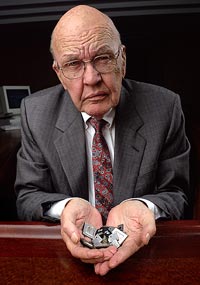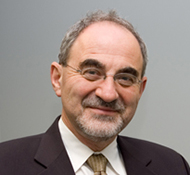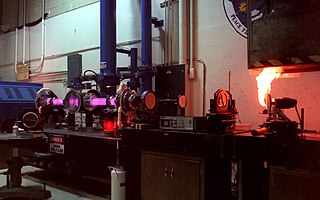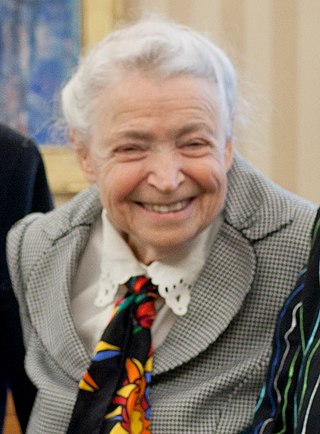
Carbon dioxide is a chemical compound with the chemical formula CO2. It is made up of molecules that each have one carbon atom covalently double bonded to two oxygen atoms. It is found in the gas state at room temperature, and as the source of available carbon in the carbon cycle, atmospheric CO2 is the primary carbon source for life on Earth. In the air, carbon dioxide is transparent to visible light but absorbs infrared radiation, acting as a greenhouse gas. Carbon dioxide is soluble in water and is found in groundwater, lakes, ice caps, and seawater. When carbon dioxide dissolves in water, it forms carbonate and mainly bicarbonate, which causes ocean acidification as atmospheric CO2 levels increase.

Jack St. Clair Kilby was an American electrical engineer who took part, along with Robert Noyce of Fairchild Semiconductor, in the realization of the first integrated circuit while working at Texas Instruments (TI) in 1958. He was awarded the Nobel Prize in Physics on 10 December 2000.

Nicolaas Bloembergen was a Dutch-American physicist and Nobel laureate, recognized for his work in developing driving principles behind nonlinear optics for laser spectroscopy. During his career, he was a professor at Harvard University and later at the University of Arizona and at Leiden University in 1973.

Nick Holonyak Jr. was an American engineer and educator. He is noted particularly for his 1962 invention and first demonstration of a semiconductor laser diode that emitted visible light. This device was the forerunner of the first generation of commercial light-emitting diodes (LEDs). He was then working at a General Electric research laboratory near Syracuse, New York. He left General Electric in 1963 and returned to his alma mater, the University of Illinois at Urbana-Champaign, where he later became John Bardeen Endowed Chair in Electrical and Computer Engineering and Physics.

Eli Yablonovitch is an American physicist and engineer who, along with Sajeev John, founded the field of photonic crystals in 1987. He and his team were the first to create a 3-dimensional structure that exhibited a full photonic bandgap, which has been named Yablonovite. In addition to pioneering photonic crystals, he was the first to recognize that a strained quantum-well laser has a significantly reduced threshold current compared to its unstrained counterpart. This is now employed in the majority of semiconductor lasers fabricated throughout the world. His seminal paper reporting inhibited spontaneous emission in photonic crystals is among the most highly cited papers in physics and engineering.

The carbon-dioxide laser (CO2 laser) was one of the earliest gas lasers to be developed. It was invented by Kumar Patel of Bell Labs in 1964 and is still one of the most useful types of laser. Carbon-dioxide lasers are the highest-power continuous-wave lasers that are currently available. They are also quite efficient: the ratio of output power to pump power can be as large as 20%. The CO2 laser produces a beam of infrared light with the principal wavelength bands centering on 9.6 and 10.6 micrometers (μm).

Mildred Dresselhaus, known as the "Queen of Carbon Science", was an American physicist, materials scientist, and nanotechnologist. She was an institute professor and professor of both physics and electrical engineering at the Massachusetts Institute of Technology. She also served as the president of the American Physical Society, the chair of the American Association for the Advancement of Science, as well as the director of science in the US Department of Energy under the Bill Clinton Government. Dresselhaus won numerous awards including the Presidential Medal of Freedom, the National Medal of Science, the Enrico Fermi Award, the Kavli Prize and the Vannevar Bush Award.

Rolf William Landauer was a German-American physicist who made important contributions in diverse areas of the thermodynamics of information processing, condensed matter physics, and the conductivity of disordered media. Born in Germany, he emigrated to the U.S. in 1938, obtained a Ph.D. in physics from Harvard in 1950, and then spent most of his career at IBM.
Calvin Forrest Quate was one of the inventors of the atomic force microscope. He was a professor emeritus of Applied Physics and Electrical Engineering at Stanford University.
A TEA laser is a gas laser energized by a high voltage electrical discharge in a gas mixture generally at or above atmospheric pressure. The most common types are carbon dioxide lasers and excimer lasers, both used extensively in industry and research; less common are nitrogen lasers. The acronym "TEA" stands for Transversely Excited Atmospheric.
Federico Capasso is an applied physicist and is one of the inventors of the quantum cascade laser during his work at Bell Laboratories. He is currently on the faculty of Harvard University.

John Roy Whinnery was an American electrical engineer and educator who worked in the fields of microwave theory and laser experimentation.
Cassius Chapin Cutler was an American electrical engineer at Bell Labs. His notable achievements include the invention of the corrugated waveguide and differential pulse-code modulation (DPCM).
Andrew H. Bobeck was a Bell Labs researcher best known for his invention of bubble memory.

William B. Bridges is the Carl F Braun Professor of Engineering, Emeritus, and Professor of Electrical Engineering and Applied Physics in the Engineering and Applied Science division at the California Institute of Technology. Born in Inglewood, California, he is the discover/inventor of the Argon Ion laser, and holds the patent for the Ionized Noble Gas Laser.
Anthony J. DeMaria is an American researcher in lasers and their applications, particularly known for his work with picosecond laser pulses.

William Happer is an American physicist who has specialized in the study of atomic physics, optics and spectroscopy. He is the Cyrus Fogg Brackett Professor of Physics, emeritus, at Princeton University, and a long-term member of the JASON advisory group, where he pioneered the development of adaptive optics. From 1991 to 1993, Happer served as director of the Department of Energy's Office of Science as part of the George H.W. Bush administration. He was dismissed from the Department of Energy in 1993 by the Clinton Administration after disagreements on the ozone hole.
Richard Magee Osgood Jr. was an American applied and pure physicist. He was Higgins Professor of Electrical Engineering and Applied Physics at Columbia University.

John E. Bowers is an American physicist, engineer, researcher and educator. He holds the Fred Kavli Chair in Nanotechnology, the director of the Institute for Energy Efficiency and a distinguished professor in the Departments of Electrical and Computer Engineering and Materials at University of California, Santa Barbara. He was the deputy director of American Institute of Manufacturing of Integrated Photonics from 2015 to 2022.












